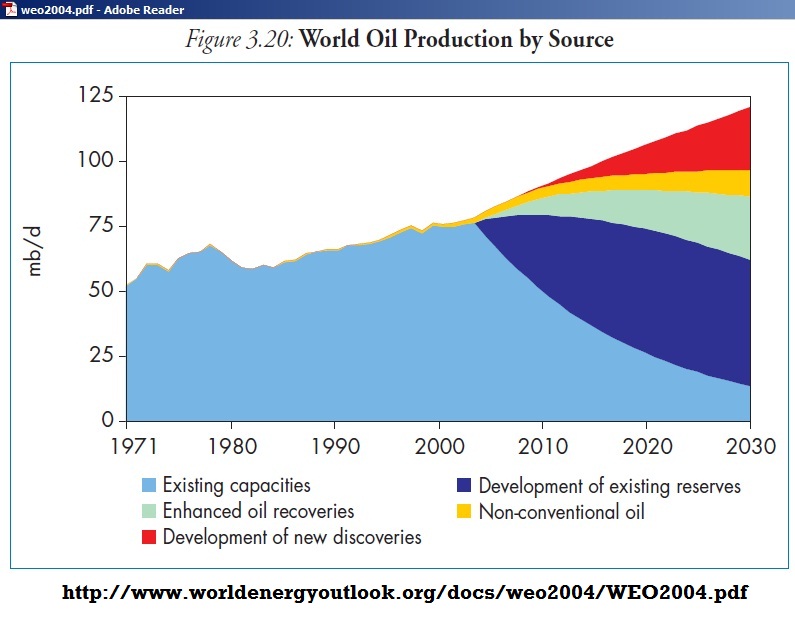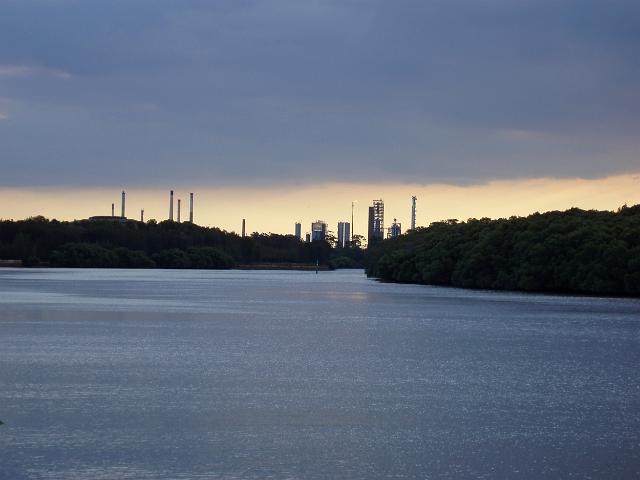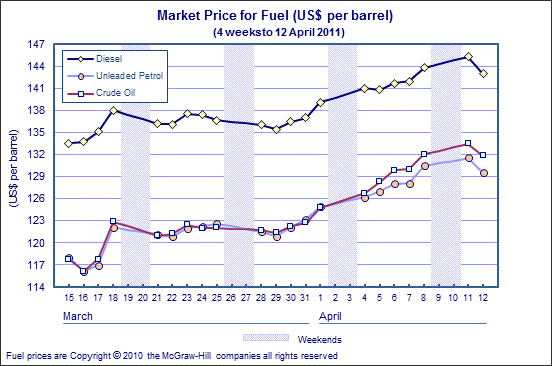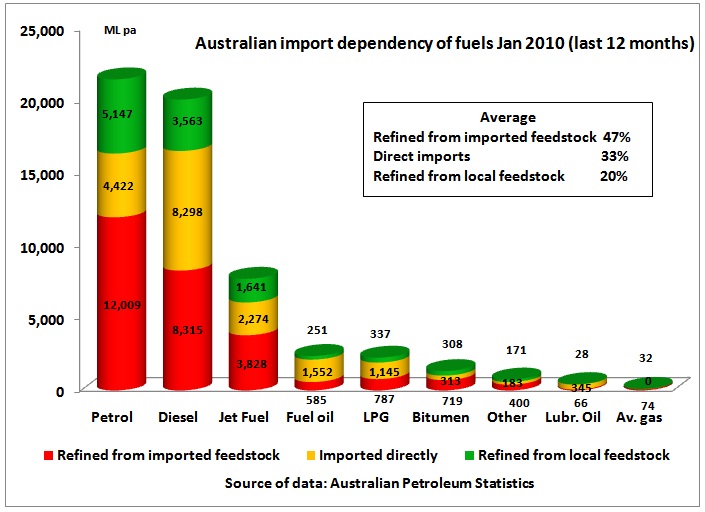Peak oil works according to plan, sweeping through the system bit by bit. Closing refineries are to be expected as global crude oil export volumes are declining. First victims are inefficient operators. We are told the Clyde refinery can’t compete any longer with much larger, recently built refineries in Asia. Ironically, they were built based on the expectation of growing demand and growing oil production. Whatever the case, after the closure of the Stanvac refinery and the sale of Mobil’s retail outlets we witness a step-wise decline of the oil sector. Governments now need to pull the emergency brake on fuel consuming projects.
Sunset on the Clyde refinery in Sydney
http://freeaussiestock.com/free
Look at the refinery margins!
http://www.aip.com.au/pricing/marketwatch.htm
IEA’s eternal growth scenario in the World Energy Outlook 2004 might have contributed to an over-investment in refinery capacities:
 In the WEO 2010, the IEA reduced its growth forecast substantially (new policies scenario) and showed the reality by hiding it in a CO2 reduction scenario. Too late.
In the WEO 2010, the IEA reduced its growth forecast substantially (new policies scenario) and showed the reality by hiding it in a CO2 reduction scenario. Too late.
http://www.worldenergyoutlook.org/publications/weo-2010/
While Australian refineries depend already now on imported crude oil for around 80% of their feedstock, see the Excel files in the Australian Petroleum Statistics
http://www.bree.gov.au/publications/aps/
table 2, column C “% indigenous”), the Clyde closure will mean an increase in the import vulnerability of finished petroleum products to the extent Clyde was using local crude. Diesel is a particular worry as demand for diesel in Asia is high (the refinery output ratio diesel/petrol in OECD Pacific is around 1.5 (average OECD is around 1) while in Australian refineries this ratio is only 0.73).
This will have an impact on food production & supply, our truck fleet in general and the running of buses and diesel locos. The petrol supply will impact on toll-ways, car dependent shopping centres and subdivisions plus the banks and super funds who have invested – and, worse, who are still investing – in this unsustainable infrastructure.
More details in the menu item “Australian graphs”
The closure also reduces Australia’s ability to process its own crude oil – which is now being exported – should a redirection of these oil exports be necessary when the global oil markets further shrink or maybe even become dysfunctional. For more technical details read this report “Supply Security” from AIP:
http://www.aip.com.au/pdf/AIP%20Paper%20-%20Maintaining%20Supply%20Reliability.pdf
The question now is whether the Clyde refinery should be mothballed – rather than dismantled – to be ready for later modification to process local crude when the emergency arrives.
The other Australian refineries face similar problems. With current policies the Federal government will not interfere with what it considers “commercial decisions”, just like State governments argue that investments in toll-ways are commercial decisions, freeing them from responsibilities when the operators go into receivership (X city, Lane Cove, Clem7 road tunnels)
We may therefore see a continuing dying off of refining capacities in Australia. Unfortunately – due to its peak oil denial mode and the untested assumption that Australia can always import whatever fuels it needs – the government is unable to think strategically to safeguard at least a minimum of domestic refining capacity (e.g. for diesel needed in food production & supplies and for other essential services), whether this is being done in licensing agreements or by financially assisting in keeping the refining capacity alive. When the crunch time comes the Feds will be forced to regulate the oil market, if not – oh horror – nationalise dying oil assets to make the country independent from an increasingly volatile global oil supply situation. This could well happen within the next 10 years.
Read how Australia survived fuel rationing in WW2:
http://www.awm.gov.au/journal/j36/petrol.asp
That gives you a foretaste of what is to come.
And here the laissez-fair response of the Federal government:
EXCERPT FROM MARTIN FERGUSON’S STATEMENT: Our preliminary assessment suggests that Shell’s proposal to convert the refinery into an import and distribution terminal would continue to provide a secure and reliable supply to the market, albeit using a different business model.
http://www.abc.net.au/pm/content/2011/s3189616.htm
SMH Business Day: Clyde loss ‘no threat’ to fuel security
THE federal government has rejected suggestions that Shell Australia’s proposal to close the country’s oldest oil refinery due to an inability to compete with Asian competitors is a threat to security of fuel supply.
If the plant is closed and converted into a fuel import terminal, as expected, Australia will be forced to obtain the 10 per cent of its oil needs that Clyde provides – 40 per cent of NSW demand – from some of the refineries that are putting it out of business
And ABC TV underestimates Australia’s petroleum import dependency:
ANDREW ROBERTSON: Shell’s proposal to close its Clyde Refinery means Australia could soon be importing up to 50 per cent of its petrol and diesel needs, which raises the issue of fuel security.
http://www.abc.net.au/lateline/business/items/201104/s3189775.htm
Well, its 80% already now, taking imported crude into account, see graph above.
As a side note: one day the diesel supply situation will become so critical that the operation of diesel buses will have to be absolutely optimized. Running buses parallel to electric rail lines (e.g. on the M2 – CBD versus Epping – Chatswood – CBD) will become unaffordable. And that’s why that Beecroft Rd bridge work blocking bus lanes to Epping station should be immediately stopped. The pulling down of the bus ramp there will be bitterly regretted.
Other consequences:
ACIL Tasman’s liquid fuel vulnerability assessment is now completely outdated, as it is based on the WEO 2006 (they just missed the WEO 2008 by weeks in November 2008 – an inexcusable ignorance or negligence by both the Federal government and the consultant)
29/5/2009
Critique ACIL Tasman liquid fuel vulnerability
http://www.crudeoilpeak.com/?p=793
Not to mention of course that the Federal government was not able to come out with an energy white paper since it came to power end 2007, using the unresolved CO2 issue as a reason for the delay. It should be noted, however, that such an energy white paper would exclude the issue of peak oil which has been conveniently tucked away in ACIL Tasman’s peak oil ignorant paper. We are still turning in circles.



